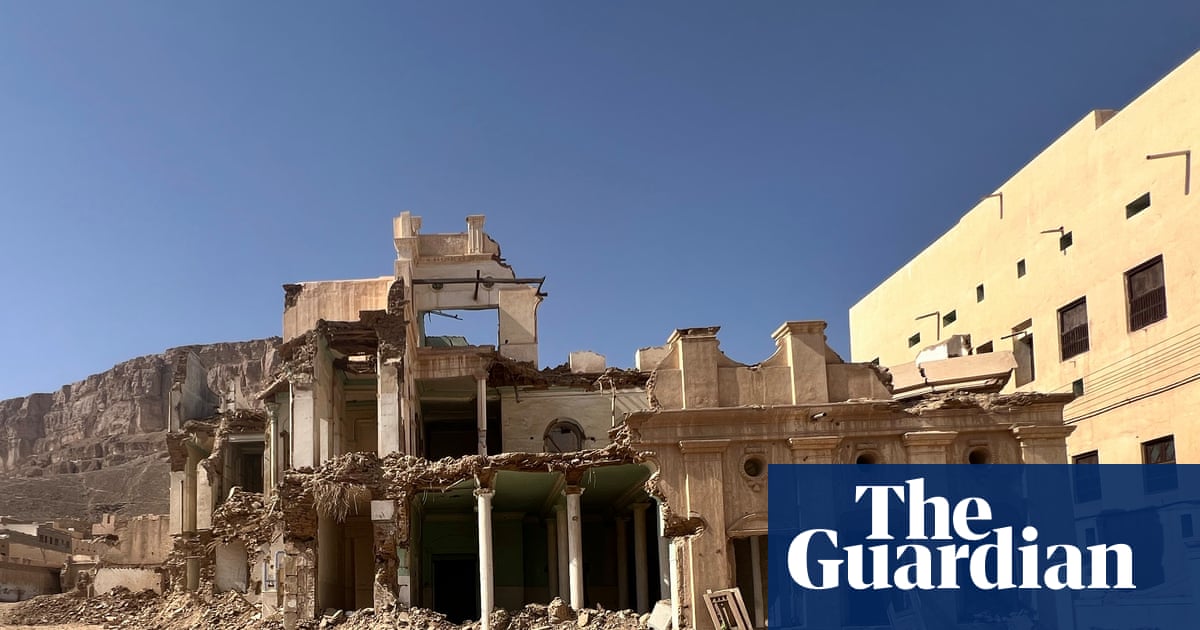When the bulldozers moved into Abdul Rahman Bin Sheikh al-Kaf’s mud-brick palace in Tarim and began tearing down its spectacular architecture, the clouds of dust around the landmark attracted a large gathering in the Yemeni city.
Haddad Musaied, a local journalist, got a call from a friend telling him about the destruction and encouraging him to come and see it. “As a journalist, you have a responsibility to stop what is happening,” the friend said.
But once at the scene in Tarim’s Aydid area, Musaied could only record with his camera the disintegration of the once marvellous palace, which had endured storms and even war over the decades. “It was heartbreaking to see Tarim’s history and legacy being quietly destroyed,” Musaied says.
The destruction of Abdul Rahman Bin Sheikh al-Kaf’s palace in Tarim has caused outrage across the city
Musaied uploaded his images on social media. His film shows about half of the magnificent palace in ruins, revealing the interiors, including exquisite roofs, whitewashed columns and wooden windows.
“Other countries would have preserved it, even if it were only 30 years old,” he says.
Sheikh al-Kaf’s home was one of 30 mud-brick palaces in Tarim, attracting many visitors to the city. It was built between the world wars by affluent members of the al-Kaf family, traders who acquired their money in Singapore during the late-19th and early-20th centuries.
Mohammed al-Kaf, the palace’s owner, blamed the Yemeni government for failing to finance repairs and said neighbours had complained about the state of the building and possible damage to nearby residences should it collapse. “I blame the government for not supporting us in maintaining the palace,” al-Kaf says.
A decorated room at the Ishshah Palace in Tarim bears the scars of years of neglect after more than a decade of war
The Tarim buildings are unique, mud-brick and colourful, and notable for combining Yemeni Hadrami architecture with south-east Asian influences, according to Ahmed al-Rubaki of the Al-Ranad Foundation for Cultural Development, which advocates for preservation. “Builders, decorators, sculptors, painters, carpenters and other artisans contributed their skills to the creation of magnificent palaces,” Rubaki says.
skip past newsletter promotion
Sign up to Global Dispatch
Get a different world view with a roundup of the best news, features and pictures, curated by our global development team
Privacy Notice: Newsletters may contain information about charities, online ads, and content funded by outside parties. If you do not have an account, we will create a guest account for you on theguardian.com to send you this newsletter. You can complete full registration at any time. For more information about how we use your data see our Privacy Policy. We use Google reCaptcha to protect our website and the Google Privacy Policy and Terms of Service apply.
after newsletter promotion
If these palaces collapse, Tarim’s history will be lost, as they are the city’s last remaining living monumentsHaddad Musaied, journalist
Tarim is also known as the bastion of Sufi Islam in Yemen and a historic centre for missionaries who spread Islam across Asia, Africa and India. In recognition of its rich cultural legacy, the Islamic World Educational, Scientific and Cultural Organization (Icesco) named Tarim the capital of Islamic culture in 2010, sparking a short-lived campaign by the Yemeni government to repaint and restore some monuments.
In August, for its cultural significance, Tarim was added to Yemen’s Unesco world heritage tentative list, a precursor to consideration for the world heritage list.
As with other historical sites across Yemen, the palaces of Tarim have suffered from more than a decade of war, leaving them abandoned and unmaintained. Al-Kaf’s palace is the most prominent, but not the first to be demolished; some have already been replaced with modern concrete buildings.
Hamtut palace, once a vibrant residence of the al-Kaf family, now stands abandoned and facing the threat of collapse
Hamtut palace, rising dramatically in one of Tarim’s densely populated neighbourhoods, with arched verandas, ornate columns and a symmetrical facade, is also owned by the al-Kaf family. On the verge of collapse, with erosion visible in the walls, the land around it has been marked out with land delineation stones, indicating portions have been sold, increasing worries for its future. “If these palaces collapse, Tarim’s history will be lost, as they are the city’s last remaining living monuments,” Musaied says.
War closed Al-Quba Palace, another mud-brick landmark bearing visible scars of years of neglect and exposure. It had been repurposed as a hotel, but part of its walls have crumbled, replaced by a rusted, sagging wire fence; its swimming pool is cracked and empty.
The once-grand swimming pool on the first floor of Hamtut Palace is covered with rubbish. The government lacks the resources to preserve the buildings
Ahmed Bahamalah, a representative of the General Authority for Antiquities and Museums, a government body responsible for handling Yemen’s historic sites, acknowledges the crisis, saying that most of Tarim’s mud-brick mansions are in a “dilapidated state” and at risk of collapse.
Bahamalah says his office, like other cash-strapped government departments, has no resources to buy, lease or restore the palaces. Their primary role, he says, is to report updates about the properties to higher authorities and advocate for their preservation. “We, like other government bodies struggling with limited resources, are working hard to preserve what can still be saved – by reporting to the concerned authorities and anyone who might help,” he says.


